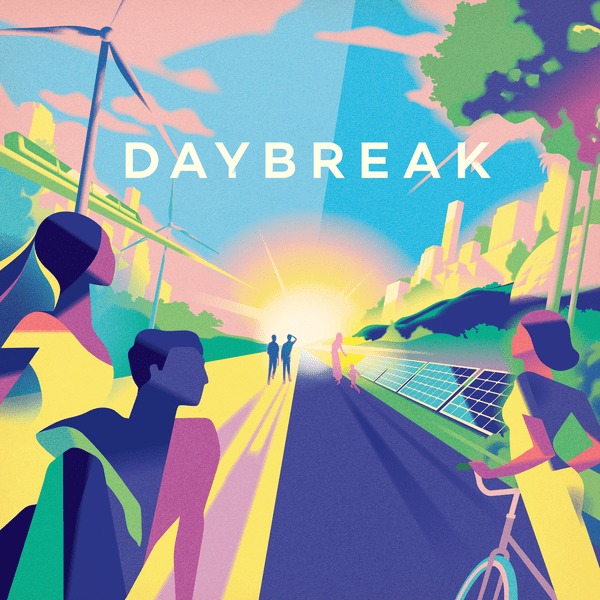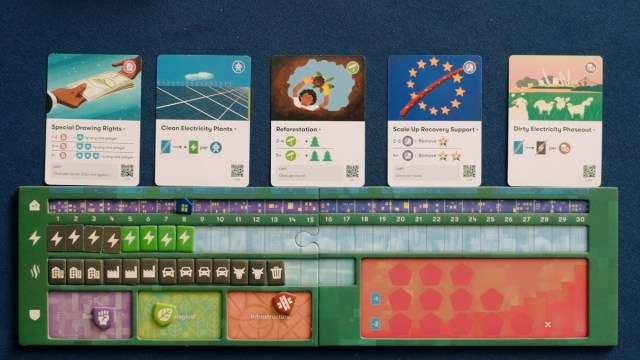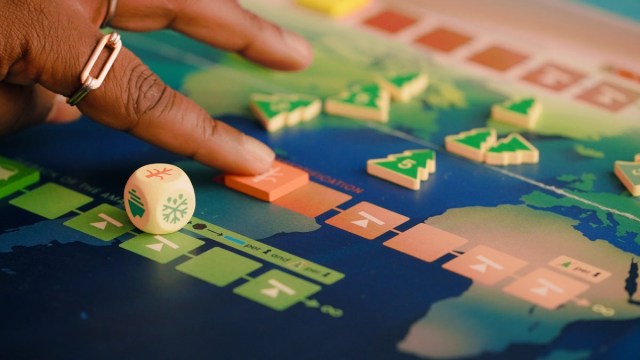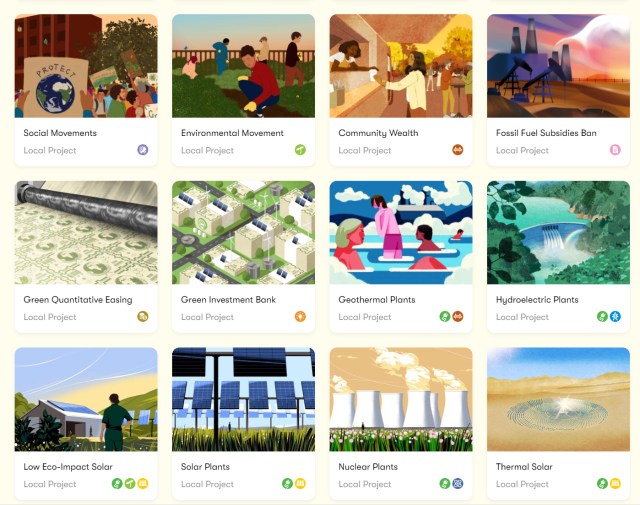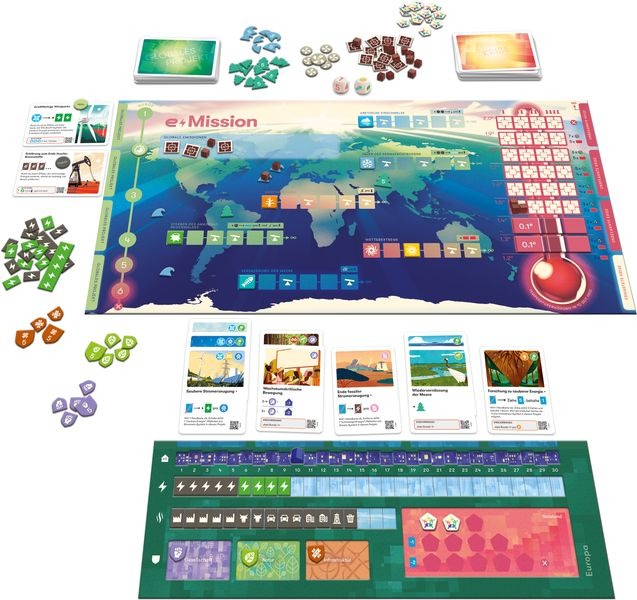Daybreak
- Designers: Matt Leacock + Matteo Menapace
- Publisher: CMYK
- Age: 10+
- Players: 1 – 4
- Time 60-90 minutes
- Played with copy provided by publisher
As part of our buildup to the announcement of the Spiel des Jahres and Kennerspiel des Jahres this weekend, we are looking at the 3 nominees for each award again.
Daybreak (aka eMission in Germany) is a co-operative game about climate action. Each player controls a world power, deploying policies and technologies to both dismantle the engine of global heating and to build resilient societies that protect people from life-threatening crises.
If the global temperature gets too high, or if too many people from any world power are in crisis, everyone loses. But if you work together to draw down global emissions to net-zero, you all win!
Daybreak is a new cooperative game by Matt Leacock, Matteo Menapace and CMYK Games (the maker of one of my favorite party games, Wavelength, and the everpopular Monikers). At a recent convention, I had the chance to play a prototype of the game with a few of my friends, and it was a great experience. I’ve been looking forward to the published version since that event, and I’m thrilled to have a copy in my hands now.
The main story of the game is climate change. The players in the game take on the role of different countries/regions of the world, and their goal is to combat rising global temperatures over the course of the game. Each of the world powers comes with its own bonus/handicaps (based on their unique starting set of cards) and energy situation as noted by chits on their board.
The main board shows a map of the world with six scattered Planetary Effect tracks on them. Global Projects tuck under the left side of the board and Crisis cards on the right. There is a huge thermometer on the right side of the board where you measure the rising temperatures as a result of the events in your game. You are also to place tree and ocean markers – you can either be thematic and place them on the map in the “right” places, or you can make things easy for gameplay and put them in nice countable stacks near the board. Your choice.
There will be decks of different cards. The Local Project cards are the main point of the game, and there is a huge deck of cards (158 to be exact). Each has a main action found at the bottom, oftentimes activated by “tags”. At the top of each card, you’ll see one or more “tag” icons. There are Global Project cards – two are drawn each round and one is put into play by the group. The Crisis cards come out in response to rising temperatures, and they provide challenges for the group to overcome.
Each player gets their own board and five starting Local Project cards. The rules tell you which World Powers to include based on player count. The top of the board shows your tracks for energy need as well as energy production and emissions production. The bottom right of the player board has an area for your “communities in crisis”, 12 in total. As you play the game, you will get more communities in crisis if you can’t control your pollution. There are also areas for you to keep track of your Resilience: Social, Ecological and Infrastructure.
The flow of each round is the same –
- Global stage – Place some Crisis cards on the board, likely some face up, some face down. (There is a chart next to the thermometer that tells you what to do based on the level of the thermometer). Reveal two Global Project cards, and the players must discuss which of the cards they want to keep. Some will add a new rule to the game while in effect, some give a bonus, but only after they are activated.
- Local Stage – each player is given a new hand of cards, usually 5 – but this can be modulated up or down based on game conditions. Each card has a main action, but cards are also a sort of currency in the game as they can also be used simply for their tags or they can be used as discards to pay for the actions found on other cards. Each player’s hand is open and laid out on the table. In this stage, you can play any cards you like from your hand, assuming you can pay for them. You have 5 stacks to play cards on (found above your board) – only the topmost (and therefore fully visible) card in each stack is active. These cards are used to improve energy production, improve emissions, mitigate emissions by planting trees, etc. You can also simply tuck some cards underneath a stack to use their tags (and forever give up their main effect). You can also use a card on the top of a stack and then later in the round cover it up and use the newly placed card. All of the tags in a stack are visible and used throughout the whole game. Cards can also be played to the Global Projects and to Crisis cards by any player. The group will likely want to discuss how they are going to each allocate their cards to these communal cards. Global Projects can be activated with the right cards tucked underneath them and some Crisis cards can be avoided if the right icons are tucked under them.
- Emissions Stage – First, make sure you are making enough power for your part of the world. If not, you’ll put a community in crisis for each energy need missed. Then add up all of your emissions and place a matching number of carbon cubes into the Recent Emissions area on the map. When all players have done this, reduce your pool of emissions based on the amount of tree and ocean markers seen on the map (showing the effects of the trees, water, etc to scrub some of the pollution). Any excess here is added to the global warming thermometer. A red thermometer bar (representing 0.1 degrees of global warming) is added for each 20 pollution cubes added to the thermometer. If you are in a good place, you might achieve Drawdown! That is, a state where you are able to deal with all of the emissions created this turn and you can then take cubes away from the Thermometer!
- Crisis stage – Roll the Planetary Effects die (aka the die of doom) – based on the current level on the thermometer, roll the die once for each temperature band… For each roll, move the marker forward one space on the corresponding track on the board. If you hit a space with a Tipping point icon on it, something bad happens. Then, deal with all the crisis cards in the stack on the right of the board. Some of them might be face up, so hopefully you’ve prepared for them! Others will be a complete surprise. Many of these cards offer negative effects, though they can be mitigated/defended if you have the right type of resilience markers. The strength of many of the crisis cards is multiplied by each red bar on the thermometer – so as the game progresses, the Crisis cards get more and more painful. Other possible penalties of a Crisis card include discarding Resilency tokens, removing tree/ocean markers from the board or having to discard cards from your hand.
- Growth stage – Check to see if you win/lose. You win if you have survived the round AND you reached Drawdown; that is the land and seas were able to absorb all your pollution, and therefore NO red cubes were added to the thermometer that round. You lose if this is the end of the sixth round, if any player has 12+ communities in crisis, if the global warming thermometer is at the top. If neither has happened, each World Power increases their energy demand and another round is played.
My thoughts on the game
Daybreak is a very compelling game – it is a cooperative game that is constantly keeping players on their toes. Every decision feels important, and every flip of an unknown card has you worried that this could be the one that triggers your doom. This is a design hallmark of Matt Leacock cooperative games, and the designer and I had a nice chat about this while we played. There are so many cooperative games coming to market these days, and it’s rare to have a game that carries this high level of tension through most of the game. In my experience, in every round except maybe the first one, there is always the feeling that you could lose the game or severely hamper your chances of success; and it is this tension that makes the game so good.
One of the issues of cooperative games for me is the Quarterback problem – that is, when one player ends up dictating the play of the entire group in the game. A big positive for me about Daybreak is that it seems quite hard for a single player to quarterback the progress of the game. Each player has their own hand of cards and player board; and frankly, it’s a lot to think about – much less what’s going on with the other players. In our game, during the Local stage, we would all keep our heads down trying to figure out how to play our cards. But, as we were doing it, we would call out suggestions: “Hey, can anyone use two power plants converted to solar?”. “Hey, I have a card that lets me pass to another player – does anyone need a funding tag? Or a nuclear tag?” “Hey, I can reveal the next two crisis cards but it’ll cost me three discarded cards – do we think that’s worth it? I will end up with one unmet energy need though”.
The game focuses on constant communication rather than Player A telling everyone else what the best plan is. The Global Project cards often led to a spirited debate over which one should be kept. Sometimes the cards simply gave a reward when put into play. The more interesting ones gave a really good reward when activated; but until that time… there was a pretty big negative effect that is always activated – so the team is really motivated to meet the needs of that card in the current round. With so many cards in play, and the fact that each player has their own set of 5 stacks to manage as well as the Global Projects and the Crisis cards to consider, the game just flows well when the players chat with themselves in that phase.
Players constantly have to decide between different actions. There are so many ways to progress, and only so many cards that you have in your hand at any time. Do you focus on your own energy needs or production? Do you give up some of your cards for the greater good? Many of the cards allow you to give resiliency tokens to other players or to remove different types of pollution – and these cards require constant conversation amongst the players so that they know what the options are.
Interestingly, I did try setting up a solo game – not with the solo rules, but as a 4p game where I played everything – and it was definitely not as fun as having a group of gamers talking and working together. My solo experiment also took much longer than a group game as I had so many things to try to consider to optimize the card play; and I had to do this for four hands each round instead of just one. This was an important lesson to me as far as cooperative games go – sometimes the game works better when it flows with conversation as opposed to being an open book puzzle for everyone to solve.
Daybreak is meant to be both entertaining and educational. Each card has a QR code on it, linking to an informational site describing aspects related to each card in the game. There has been a lot of real research done into the topics for each of the cards – if you want to see more: https://daybreakgame.org/explore-cards
The theme of the game is pervasive, and it extends to the production as well. The game uses no plastic components, and 100% FSC certified wood and paper products. For me, the biggest thing was this means no shrinkwrap. The game was instead sealed with four green stickers on the box. Personally, I’m not a fan of this. My OCD Gamer mind doesn’t like the sticker remnants on the box – but I can certainly see that this is better for the environment. To each their own, I guess. The contents of the box come nicely stored in paper boxes, and that is a very nice alternative to plastic baggies. More and more game companies seem to be moving towards reducing the use of plastic in games, so this is something I might just have to get used to.
The rules are well done, though quite verbose. The rulebook is a hefty 40 pages – though the actual rules don’t start until page 14. The initial portion of the book is filled with some introductory information; almost like a trailer of the actual rules. It’s a different approach to rulebooks, but I’ve heard a number of non-gamers find it less intimidating to have the game broken down to the basics at the start and then all the actual rules later. Once you get to the rules, it’s easy to read and we didn’t have any questions which we needed to refer to the rules later (and we didn’t have to go look online either). So that’s a plus.
Though there are a lot of things to consider, the game feels fast as it plays – because you are constantly trying to figure out what to do with your cards. Recent games have come in just over an hour, and this was with players who game casually (though they have experience with games such as Pandemic and TTR). Most of my games are coming down to the last round, so the difficulty level feels right for me. However, for those groups who are better at cooperative games than me – there are challenge cards which can be added to make things more difficult. Lets just say that my little pink box of challenge cards remains unopened and likely will remain so forever. I’m enjoying Daybreak just as it is.
Thoughts from other Opinionated Gamers
Lorna: I really enjoyed my one play with 2 players. I found the simultaneous play mechanism great as it moves the play along and keeps players from telling each other what to do. The theme is spot on.
Mark Jackson (5 plays): I’d agree with Dale’s assessment about the importance of conversation, the built-in design elements that prevent quarterbacking, the high level of tension throughout the game, and his extremely positive review in general. I would add that using the actual solo rules in the game works – though I haven’t yet gotten close to winning. As well, there are three varieties of challenge cards: those which make the game tougher, those which make the game easier, and those which change the game structure up in some form or fashion. (And, no, we haven’t used any of them yet. I’m tempted in my next solo game.)
Jonathan: (3 plays on BGA – not physically played) – I like the game as a card manipulation game with your own tableau and the ability to call on others as needed. In that way, it felt like Spirit Island where you are playing your role and communicating when necessary. Playing the game online removes the fiddling and tracking of all the little bits. Given the amount of bookkeeping during the resolution phase (after playing cards), online might be better than in person, which is sad, but also a trend in modern game designs.
Ratings from the Opinionated Gamers
- I love it! Dale Y, Mark Jackson, Jonathan (online implementation)
- I like it. Lorna, Steph H
- Neutral.
- Not for me…

